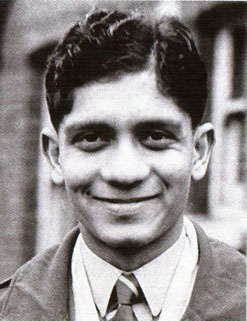Cricket has its fair share of sad tales, but few are nearly as tragic as that of James Mackay aka 'Sunny Jim', the opening batsman from New South Wales whose batting was considered to be on a similar level to that of the great Victor Trumper. He was said to have pretty much all the gifts a batsman covets - be it power, timing, precision, the ability to bat on any kind of wicket not unlike Trumper himself, and a penchant for big scores with the bat. However, there was just one thing that he didn't have - luck.
By the time Mackay made his first-class debut in the 1902/03 season, he had already gained something of a legendary status in grade and country cricket in Australia, where he would mercilessly dominate bowling attacks and score hundreds almost at will regardless of who he played against - there was a sequence of him once scoring 104*, 128*, 108*, 200* and 65* in five successive innings i.e 605 runs without being dismissed for his grade team in 1900/01. To top it off, he scored a peerless 106 in the final of the grade competition for a Combined Country XI against a Paddington side that included Victor Trumper and Monty Noble among others.
But the jump from grade to Sheffield Shield cricket proved to be a steep learning curve for him, as he crossed fifty only twice in eleven innings at the crease averaging a meagre 16.50 over his first two seasons of first-class cricket. The talent that was evidently there as witnessed by Archie MacLaren's tourists in 1901/02 when he scored 68 against an bowling lineup consisting of Sydney Barnes and Len Braund among others, finally bore fruit in 1904/05 when he brought up his maiden first-class hundred with a scintillating 131 against Queensland at The Gabba. He finished the season with 242 runs at 40.33, but it wasn't enough to get him selected for the 1905 Ashes series in England to the disappointment of some.
During the next cricketing season in 1905/06, he showed the Australian selectors what they had been missing in the most dominant manner possible, with an astounding 902 runs at an average of 112.75 with 5 centuries from only 5 matches - leading the season averages by a country mile and outperforming Test stars such as Trumper (250 runs at 41.66), Noble (631 runs at 90.14) and Hill (279 runs at 46.50) in the process. Had Australia played any international cricket during this period, there was little doubt he would have been selected as Trumper's opening partner and perhaps ended a career or two. But their next Test match assignment came only in 1907/08, by which time Mackay had all but left Australian cricket behind for search of better working opportunities in South Africa under the employ of South African diamond tycoon Sir Abe Bailey.
He was an automatic pick for Transvaal for whom he scored 247 runs at 35.28 in his first season playing in South Africa, and it seemed only a matter of time before their Test selectors would came calling. That is when life struck him down in the cruellest manner possible in the form of a motorcycle driver who accidentally knocked him over whilst he was talking a walk, rendering him unconscious for several days due to a brain concussion and permanently damaging his eyesight in the right eye. Mackay never recovered from it, and was forced to prematurely end his fledgling but already impressive first-class career aged only 27. His first-class record read 1556 runs at an average of 50.19 with 6 centuries and 7 fifties from just 20 matches.
He did attempt a comeback via grade cricket in 1917 after moving back to his native Australia, but resembled a pale shadow of the player he once was and bagged a pair, forcing him to settle on life in the NSW country as a sheep farmer where he lived out the rest of his days. But one couldn't help but think what might have been if fate had been kinder and allowed him to express the full extent of his cricketing talent, which many believed would have surpassed that of Trumper. In the words of Clem Hill, who shared many a great moment with Trumper at Test level and even captained him, the man nicknamed 'Sunny Jim' for his ever smiling persona "was undoubtedly the best player that Australia produced who never reached a Test match. He was a batsman after the Trumper type and it is just possible that if he had gone home with the Australian Eleven and toured England he might have proved in time as marvellous as the illustrious Victor.”
Playing role
Mackay shall open the innings alongside Patterson, playing the role of the aggressor to the latter's anchor. I don't expect too many bowlers will particularly enjoy bowling to him - with two good eyes and at the peak of his powers, he was simply impossible to bowl at. Think a 1900s version of Virender Sehwag, but who could actually bat on tough wickets.
Stats and trivia
- Mackay played a total of 20 first-class matches scoring 1556 runs at 50.19 with 6 centuries and 7 fifties to his name between 1902/03 and 1906/07.
- He was the first player in the history of the Sheffield Shield to score two centuries in a single match, a feat he achieved during his record breaking 1905/06 season.
- His first-class best score of 203 came against Queensland in 1905/06. He scored a total of 902 runs in the season at an average of 112.75 with 5 centuries, comfortably beating Algy Gehrs (583 runs at 97.16) and Monty Noble (631 runs at 90.14) on the season averages.
- In a match against an Australian XI in 1905/06, he scored 136 runs in 207 minutes with 16 boundaries for New South Wales against a bowling attack consisting of Monty Noble, Tibby Cotter, Warwick Armstrong and Bill Howell. The next highest score in the match was 100 by Noble.
- He scored a total of 2449 runs at an average of 59.50 at First Grade level, putting him on par with the likes of Archie Jackson (3084 at 58.18), Bob Simpson (10188 at 60.28), Victor Trumper (9244 at 62.03), Sid Barnes (6582 at 62.09) in terms of averages. Don Bradman (3221 at 89.47) as one might expect, heads the list.
- Mackay's 1905/06 season also included 1041 runs at an average of 104 for Burwood District Cricket Club in First Grade cricket.
- He scored 247 runs at 35.28 for Transvaal in what turned out to be his final season of first-class cricket in 1906/07.
VC's XI
1. 
 George Patterson
George Patterson
2. 
 Sunny Jim Mackay
Sunny Jim Mackay
3.
4.
5.
6.
7. 
 Ryan Campbell
Ryan Campbell
8. 
 Bart King
Bart King
9.
10.
11.
Your turn, @blockerdave.
 Franklyn Stephenson
Franklyn Stephenson 
 Don Shepherd
Don Shepherd 





















